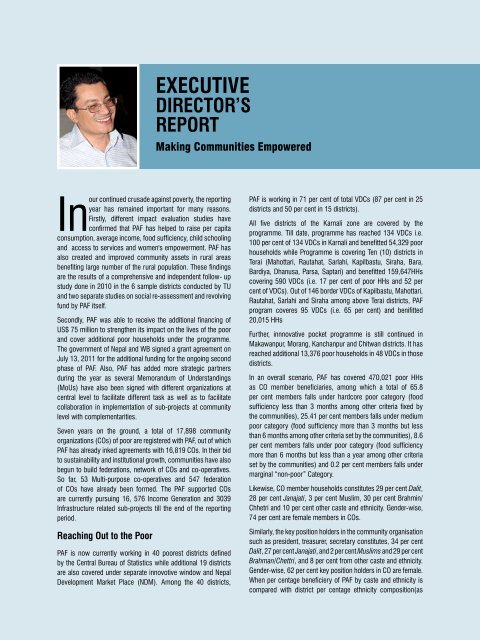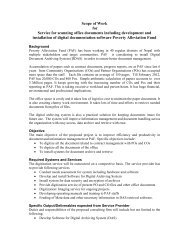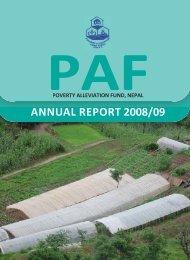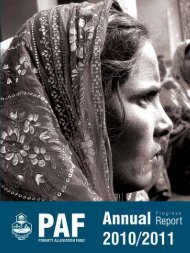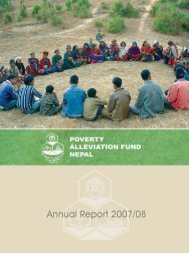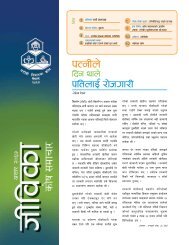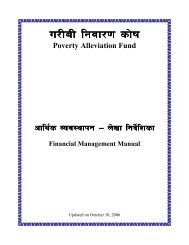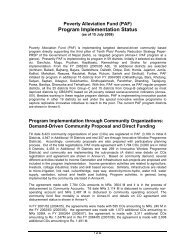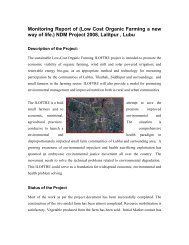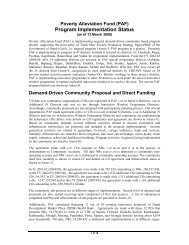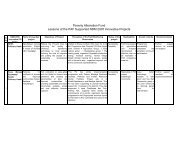Fiscal year 2010/11 - Poverty Alleviation Fund, Nepal
Fiscal year 2010/11 - Poverty Alleviation Fund, Nepal
Fiscal year 2010/11 - Poverty Alleviation Fund, Nepal
You also want an ePaper? Increase the reach of your titles
YUMPU automatically turns print PDFs into web optimized ePapers that Google loves.
Executive<br />
Director’s<br />
Report<br />
Making Communities Empowered<br />
In<br />
our continued crusade against poverty, the reporting<br />
<strong>year</strong> has remained important for many reasons.<br />
Firstly, different impact evaluation studies have<br />
confirmed that PAF has helped to raise per capita<br />
consumption, average income, food sufficiency, child schooling<br />
and access to services and women's empowerment. PAF has<br />
also created and improved community assets in rural areas<br />
benefiting large number of the rural population. These findings<br />
are the results of a comprehensive and independent follow- up<br />
study done in <strong>2010</strong> in the 6 sample districts conducted by TU<br />
and two separate studies on social re-assessment and revolving<br />
fund by PAF itself.<br />
Secondly, PAF was able to receive the additional financing of<br />
US$ 75 million to strengthen its impact on the lives of the poor<br />
and cover additional poor households under the programme.<br />
The government of <strong>Nepal</strong> and WB signed a grant agreement on<br />
July 13, 20<strong>11</strong> for the additional funding for the ongoing second<br />
phase of PAF. Also, PAF has added more strategic partners<br />
during the <strong>year</strong> as several Memorandum of Understandings<br />
(MoUs) have also been signed with different organizations at<br />
central level to facilitate different task as well as to facilitate<br />
collaboration in implementation of sub-projects at community<br />
level with complementarities.<br />
Seven <strong>year</strong>s on the ground, a total of 17,898 community<br />
organizations (COs) of poor are registered with PAF, out of which<br />
PAF has already inked agreements with 16,819 COs. In their bid<br />
to sustainability and institutional growth, communities have also<br />
begun to build federations, network of COs and co-operatives.<br />
So far, 53 Multi-purpose co-operatives and 547 federation<br />
of COs have already been formed. The PAF supported COs<br />
are currently pursuing 16, 576 Income Generation and 3039<br />
Infrastructure related sub-projects till the end of the reporting<br />
period.<br />
Reaching Out to the Poor<br />
PAF is now currently working in 40 poorest districts defined<br />
by the Central Bureau of Statistics while additional 19 districts<br />
are also covered under separate innovotive window and <strong>Nepal</strong><br />
Development Market Place (NDM). Among the 40 districts,<br />
PAF is working in 71 per cent of total VDCs (87 per cent in 25<br />
districts and 50 per cent in 15 districts).<br />
All five districts of the Karnali zone are covered by the<br />
programme. Till date, programme has reached 134 VDCs i.e.<br />
100 per cent of 134 VDCs in Karnali and benefitted 54,329 poor<br />
households while Programme is covering Ten (10) districts in<br />
Terai (Mahottari, Rautahat, Sarlahi, Kapilbastu, Siraha, Bara,<br />
Bardiya, Dhanusa, Parsa, Saptari) and benefitted 159,647HHs<br />
covering 590 VDCs (i.e. 17 per cent of poor HHs and 52 per<br />
cent of VDCs). Out of 146 border VDCs of Kapilbastu, Mahottari,<br />
Rautahat, Sarlahi and Siraha among above Terai districts, PAF<br />
program coveres 95 VDCs (i.e. 65 per cent) and benifitted<br />
20,015 HHs<br />
Further, innnovative pocket programme is still continued in<br />
Makawanpur, Morang, Kanchanpur and Chitwan districts. It has<br />
reached additional 13,376 poor households in 48 VDCs in those<br />
districts.<br />
In an overall scenario, PAF has covered 470,021 poor HHs<br />
as CO member beneficiaries, among which a total of 65.8<br />
per cent members falls under hardcore poor category (food<br />
sufficiency less than 3 months among other criteria fixed by<br />
the communities), 25.41 per cent members falls under medium<br />
poor category (food sufficiency more than 3 months but less<br />
than 6 months among other criteria set by the communities), 8.6<br />
per cent members falls under poor category (food sufficiency<br />
more than 6 months but less than a <strong>year</strong> among other criteria<br />
set by the communities) and 0.2 per cent members falls under<br />
marginal “non-poor” Category.<br />
Likewise, CO member households constitutes 29 per cent Dalit,<br />
28 per cent Janajati, 3 per cent Muslim, 30 per cent Brahmin/<br />
Chhetri and 10 per cent other caste and ethnicity. Gender-wise,<br />
74 per cent are female members in COs.<br />
Similarly, the key position holders in the community organisation<br />
such as president, treasurer, secretary constitutes, 34 per cent<br />
Dalit, 27 per cent Janajati, and 2 per cent Muslims and 29 per cent<br />
Brahman/Chettri, and 8 per cent from other caste and ethnicity.<br />
Gender-wise, 62 per cent key position holders in CO are female.<br />
When per centage beneficiery of PAF by caste and ethnicity is<br />
compared with district per centage ethnicity composition(as<br />
ANNUAL PROGRESS REPORT (<strong>2010</strong>/20<strong>11</strong>)<br />
v


